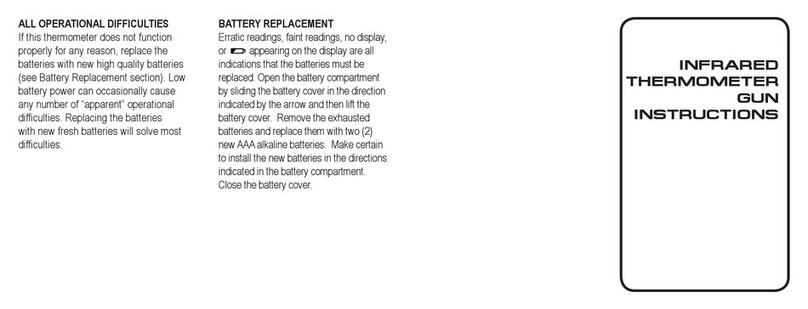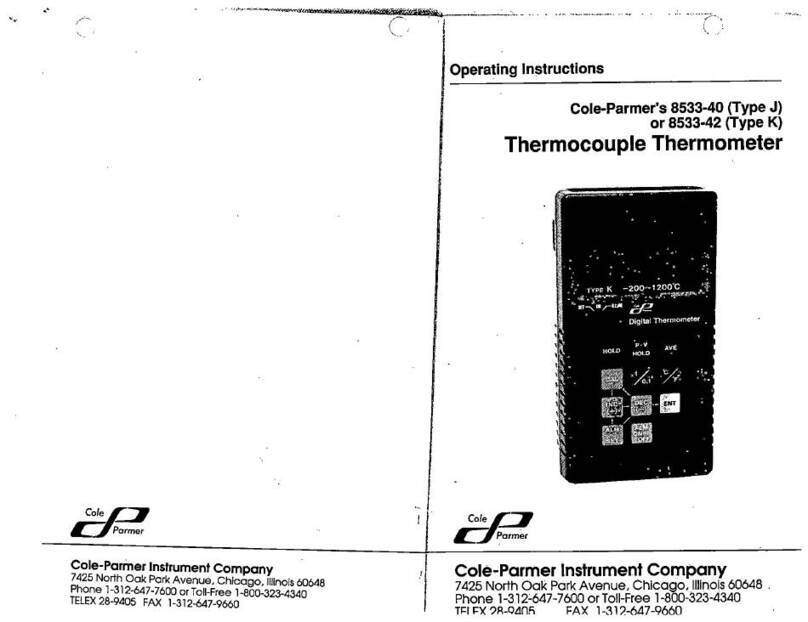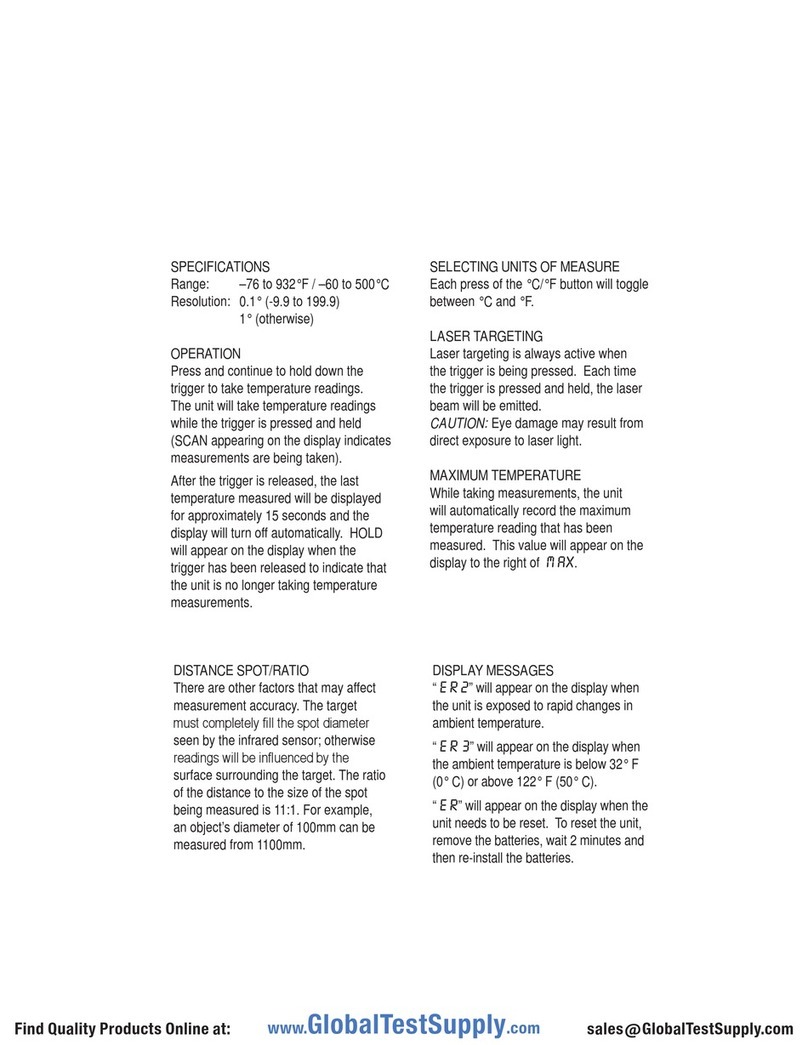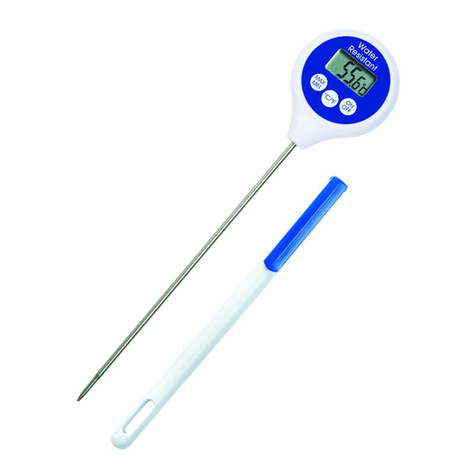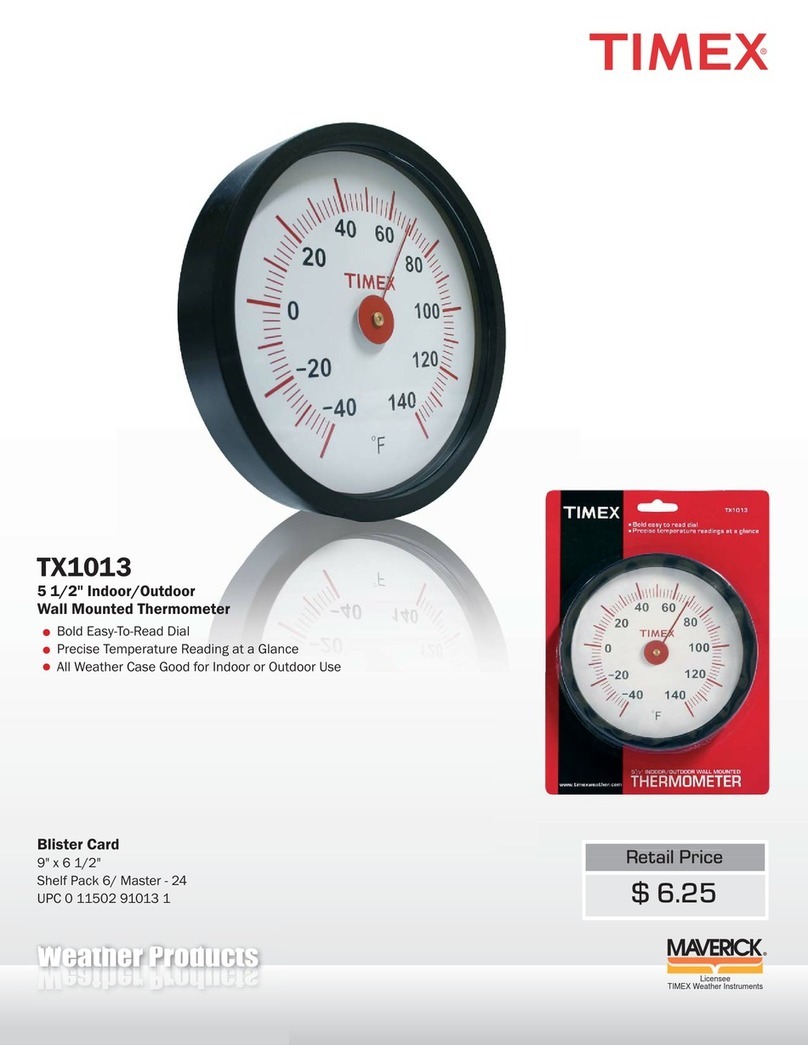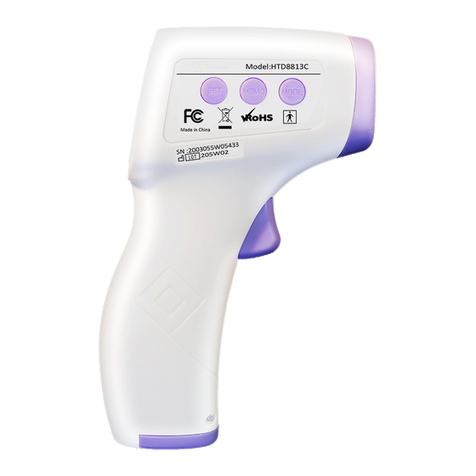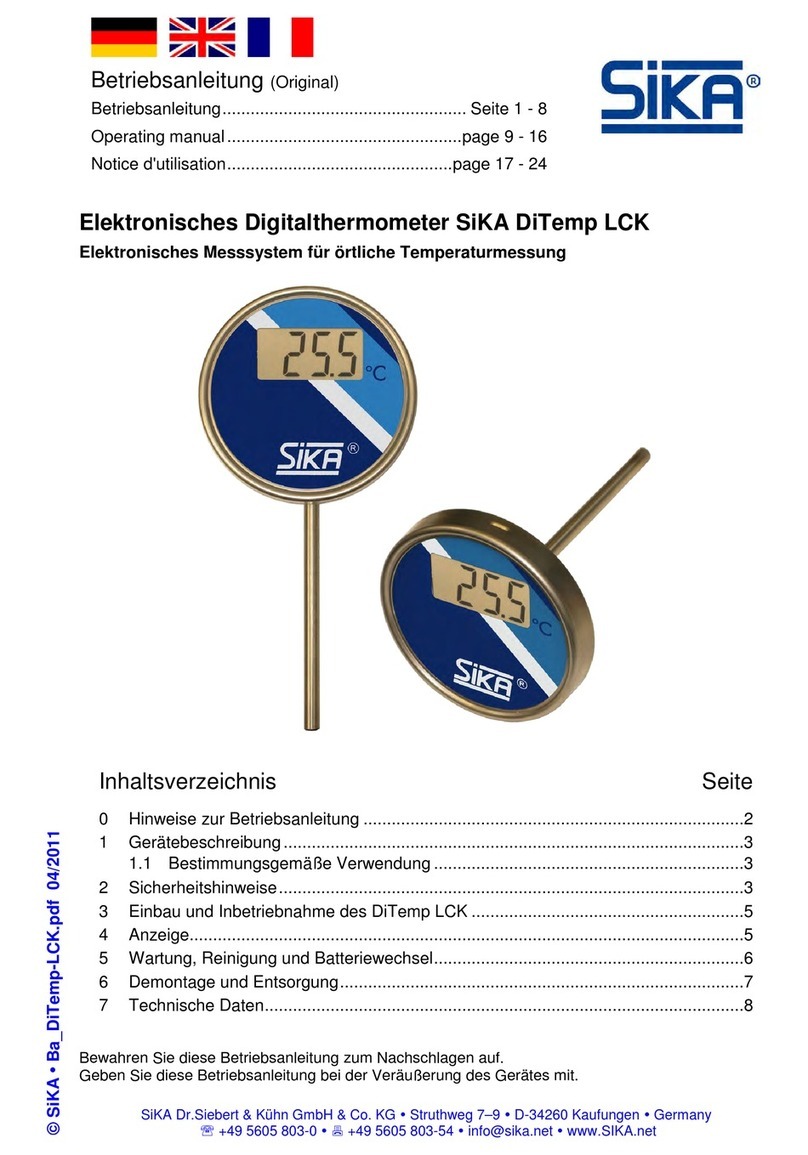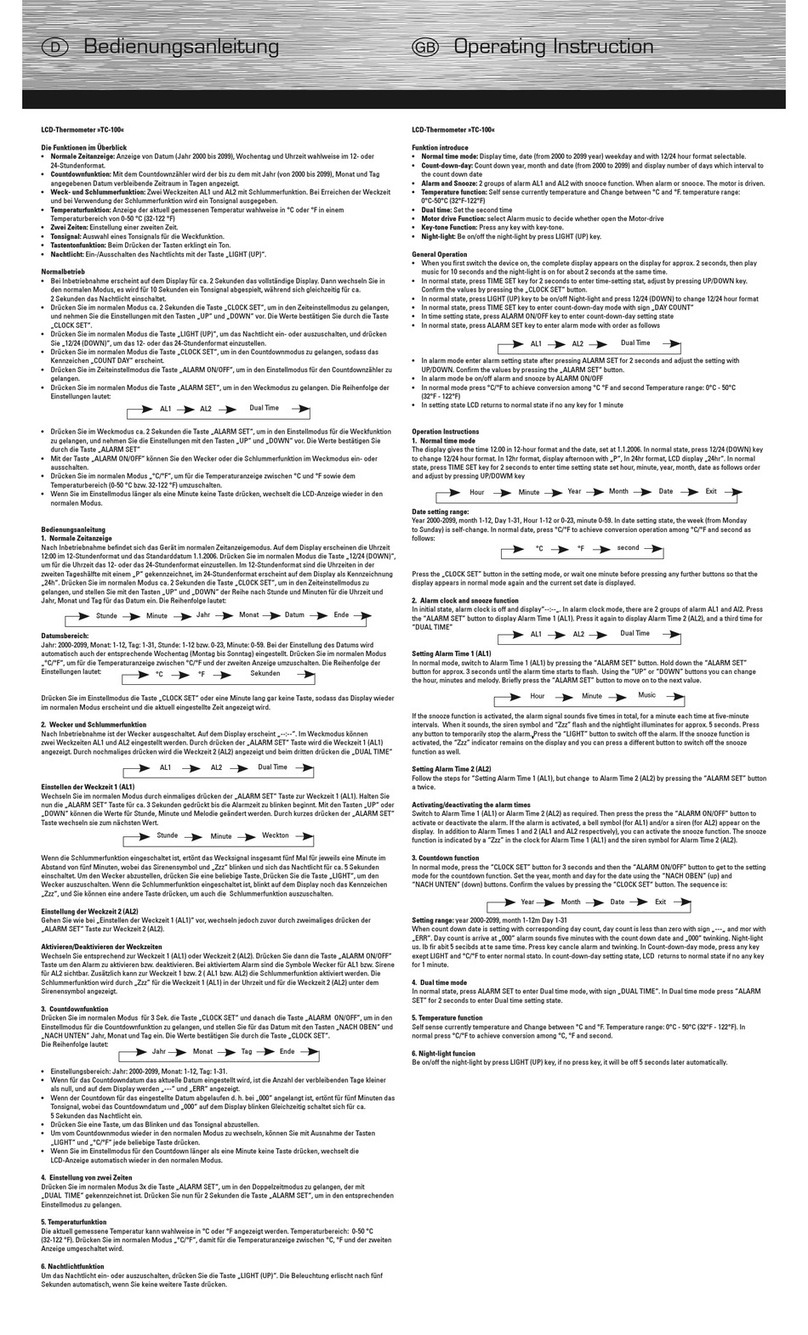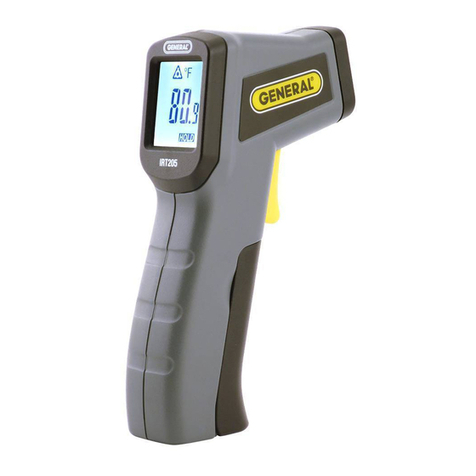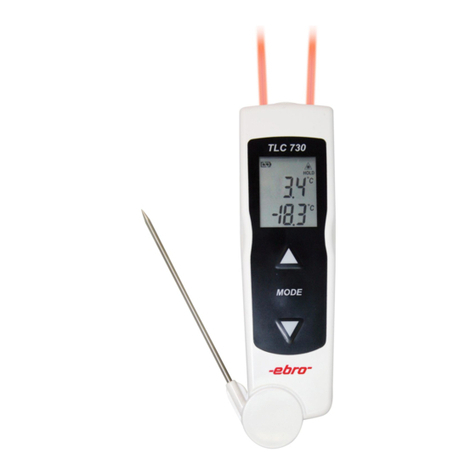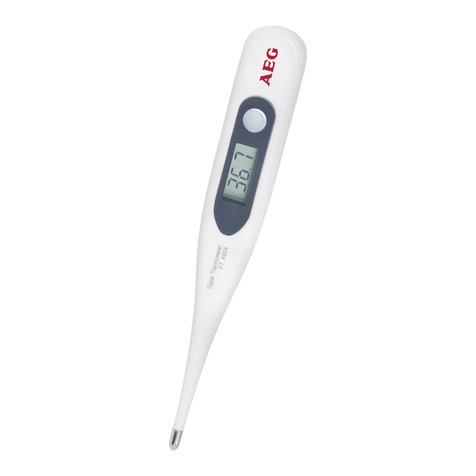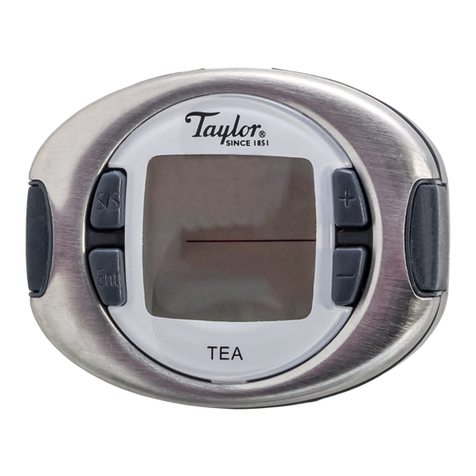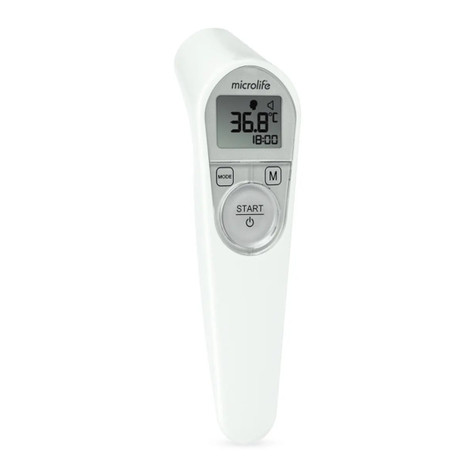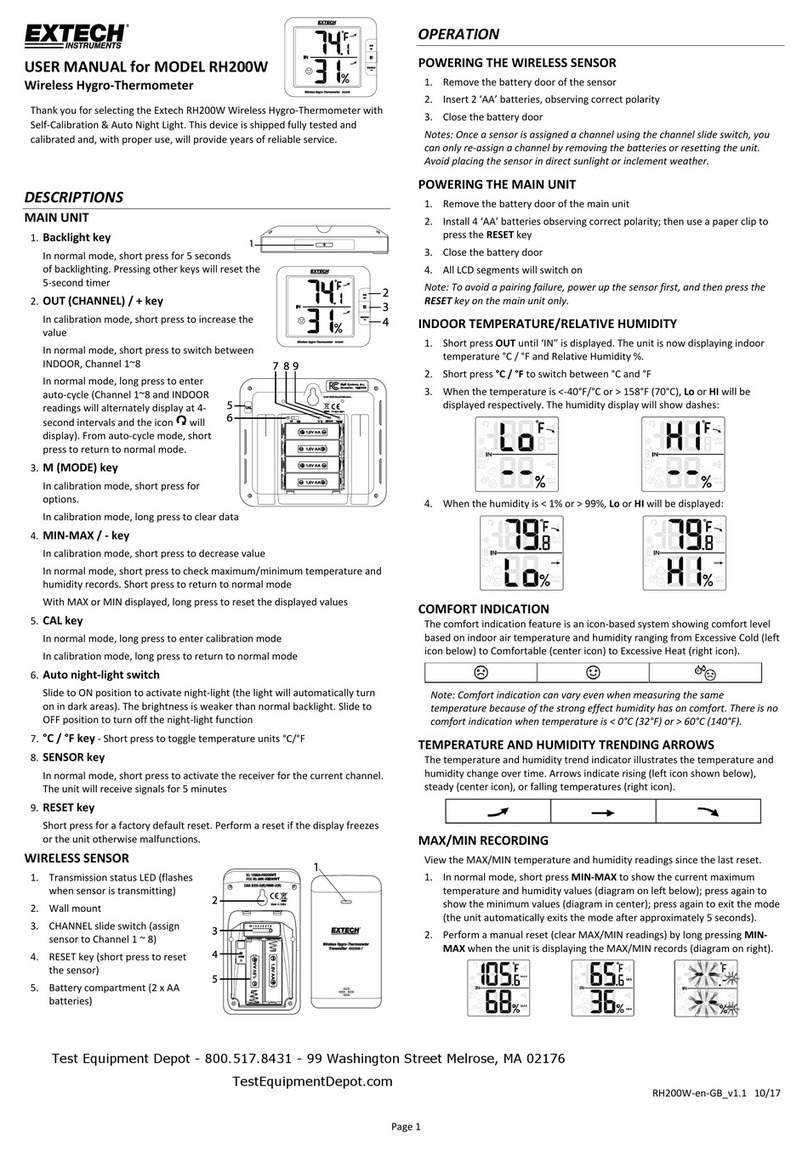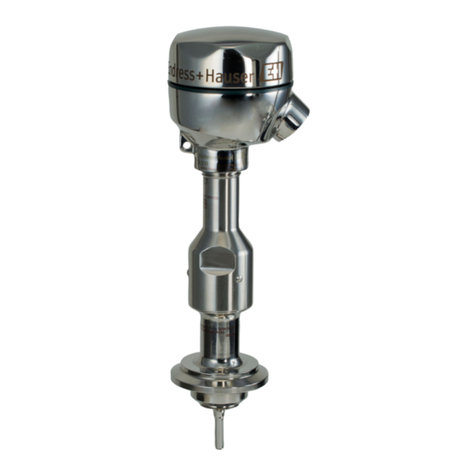Cole Parmer Digi-Sense J User manual

Thermocouple
Thermometer Models
91100-00 (Type J)
91100-10 (Type K)
91100-20 (Type T)
Cole-Parmer Instrument Company
625 East Bunker Court
Vernon Hills, Illinois U.S.A. 60061-1844
(847) 549-7600
(847) 247-2929 (Fax)
800-323-4340
www.coleparmer.com
e-mail: [email protected]
A-1299-0628
68X309906 Rev 1 04/04



TABLE OF CONTENTS
INTRODUCTION ........................................1
SAFETY PRECAUTIONS...........................2
SPECIFICATIONS......................................4
SETUP AND OPERATING PROCEDURES7
SELF TEST.................................................9
CONNECTING A THERMOCOUPLE.......10
SELECTING TEMPERATURE SCALE.....14
HOLD FUNCTON .....................................15
CALIBRATION..........................................15
CANCELING A FIELD CALIBRATION .....17
FIELD CALIBRATION LOCKOUT AND RE-
ENABLE..........................................17
MAINTENANCE........................................19
CLEANING................................................19
BATTERIES..............................................19
ACCESSORY THERMOCOUPLE PROBES19
SERVICE ..................................................22

INTRODUCTION
This versatile hand-held instrument
provides highly accurate temperature
measurements. The instrument is designed
for easy operation and includes the
following features:
• Operator selection of Celsius or
Fahrenheit scale
• Resolution of 0.1° from –99.9 to 299.9°
• Four-digit LCD
• Hold feature for temporarily retaining a
reading
• Field calibration capability
• Low battery warning
• Built-in tilt stand for easy hands-free
operation
• Two blade female ANSI mini-connector
input
• Operates with a wide selection of probes

2
SAFETY PRECAUTIONS
WARNING: THIS INSTRUMENT IS
DESIGNED TO ACCEPT LOW LEVEL
SIGNALS SUPPLIED BY STANDARD
THERMOCOUPLES. UNDER NO
CIRCUMSTANCES SHOULD THE INPUT
VOLTAGE EXCEED THE SPECIFIED 50V
RMS.
CAUTION: DO NOT USE OR STORE
THIS INSTRUMENT IN MICROWAVE
OVENS OR ANY ABNORMALLY HOT OR
COLD AREAS.
CAUTION: WEAK BATTERIES SHOULD
NOT BE LEFT IN THE INSTRUMENT.
DEAD BATTERIES CAN LEAK AND
CAUSE DAMAGE TO UNIT.
DANGER: VOLTAGES PRESENT AT THE
THERMOCOUPLE MAY ALSO BE
PRESENT AT THE BATTERY
TERMINALS. ALWAYS DISCONNECT
THE THERMOCOUPLE WHEN
CHANGING BATTERIES.

3
WARNING: TO PREVENT IGNITION OF A
HAZARDOUS ATMOSPHERE,
BATTERIES MUST ONLY BE CHANGED
IN AN AREA KNOWN TO BE NON-
HAZARDOUS.
AVERTISSEMENT: AFIN DE PREVENIR L
' I N F L A M M AT I O N
D'ATMOSPHERES DANGEREUSES, NE
CHANGER LES BATTERIES QUE DANS
DES EMPLACEMENTS DESIGNES NON
DANGEREUX.
WARNING: TO PREVENT IGNITION OF A
HAZARDOUS ATMOSPHERE BY
ELECTROSTATIC DISCHARGE, CLEAN
WITH DAMP CLOTH.

4
SPECIFICATIONS
THERMOCOUPLE PROBES
Type Temperature range
Type J –200°C to 1000°C
(–328°F to 1832°F )
Type K –250°C to 1372°C
(–418°F to 2501°F )
Type T –250°C to 400°C
(–418°F to 752°F )
Out of range display: - - - -
Resolution
0.1°/1° autoranging, 0.1° from –99.9° to
299.9°, 1° outside this range.
Accuracy
> –99.9°: +(0.2% of reading +0.5°C)
+(0.2% of reading +0.9°F)
< –99.9°: +(0.25% of reading, +1°C)
+(0.25% of reading +2°F)
Display
4-digit LCD with 0.5 in high numerals.
Display update rate
0.6 sec per update.

5
Input
One thermocouple with ANSI connector.
Input Protection
50V rms
Battery
Two AA, 1.5V alkaline ANSI-L40, IEC-LR6.
Battery Life: 750 hours continuous, typical.
Low battery indication
Battery Symbol on when 8 to 10 hours of
battery life remains.
Battery symbol blinking: replace battery
Operating Conditions
Stated accuracy:
18°C to 28°C (64°F to 82°F)
Useful range:
0°C to 40°C (32°F to 104°F)
Storage:
–40°C to 65°C (–40°F to 149°F)
Humidity (non-condensing):
10% to 90% 4
Dimensions
3 cm D x 8.4 cm W x 15.8 cm H
(1.2 in x 3.3 in x 6.2 in)
Weight with batteries

6
227 grams (8 ounces)
Ingress protection
Meets IEC-529 IP-54 for dust and water
resistant enclosures.
Intrinsic safety
This product is energy limited for
intrinsically safe operation in hydrogen
atmospheres per Class I, Division 1,
Groups A, B, C and D
hazardous(classified) locations for UL per
UL913 and CSA per C22.2 No. 0-M1982
and No. 157-M1987. Maximum surface
temperature: 135°C (T4); UL file No.
E182612 (1997).
Electromagnetic Compatibility
(For CE Mark) EN61326-1/1A: 1998 (EU
EMC Directive)

7
SETUP AND OPERATING
PROCEDURES
BATTERY INSTALLATION AND
REPLACEMENT
If battery indicator turns on, battery life is
approximately 8 to 10 hours. The battery
indicator will start blinking with less than 1
hour of life remaining.
Selected settings are stored in memory
and will remain in memory even after
power is turned off, or while batteries are
being replaced.
1. Before changing battery, turn instrument
off and disconnect thermocouple.
2. Loosen screw and lift battery cover off
back of case.
3. Remove the two AA batteries.
4. Insert two new batteries observing
polarity.
5. Install cover and tighten screw.

8
CAUTION: WEAK BATTERIES SHOULD
NOT BE LEFT IN THE INSTRUMENT.
DEAD BATTERIES CAN LEAK AND
CAUSE DAMAGE TO UNIT.
DANGER: VOLTAGES PRESENT AT THE
THERMOCOUPLE MAY ALSO BE
PRESENT AT THE BATTERY
TERMINALS. ALWAYS DISCONNECT
THE THERMOCOUPLE WHEN
CHANGING BATTERIES.

9
WARNING: TO PREVENT IGNITION OF A
HAZARDOUS ATMOSPHERE,
BATTERIES MUST ONLY BE CHANGED
IN AN AREA KNOWN TO BE NON-
HAZARDOUS.
AVERTISSEMENT: AFIN DE PREVENIR L
' I N F L A M M AT I O N
D'ATMOSPHERES DANGEREUSES, NE
CHANGER LES BATTERIES QUE DANS
DES EMPLACEMENTS DESIGNES NON
DANGEREUX.
SELF TEST
Press the ON/OFF key. The thermometer
performs a self-test and all display digits
and indicators, as shown below, should
remain on for approximately one second.

10
CONNECTING A THERMOCOUPLE
Use the correct thermocouple type for your
instrument. Using an incorrect
thermocouple type will result in erroneous
readings. Thermocouples are color coded
by type using the North American ANSI
Color Code as follows:
TYPE COLOR
J Black
K Yellow
T Blue
Thermocouple connectors have one wide
blade and one narrow blade. Do not force
connector in backwards. Connect
thermocouple to receptacle at top of
instrument as shown in the following
illustration.

11
Thermocouple wiring polarity must be
correct. If readings decrease as the
temperature increases, the thermocouple
wires may be reversed. The red wire is
negative for thermocouple wires
manufactured in North America.

12

13

14
If a thermocouple is not connected or if the
thermocouple is defective, the display will
indicate OPEn.
Thermocouples are sensitive at the tip or
measuring junction. When taking
measurements, allow time for the reading
to stabilize. Multiplying the time constant of
the probe by 5 will give you the
approximate time required.
SELECTING TEMPERATURE SCALE
Select °C or °F by pressing the °C/°F key.
Each time the key is pressed the
temperature scale will switch. Switching
between °C and °F can be done at any
time during operation.
Each time you turn the instrument on, it will
power up with the same settings that were
set when the unit was last turned off.

15
HOLD FUNCTON
Press the HOLD key to retain the reading
on the display. Press the HOLD key again
for normal operation.
CALIBRATION
The thermometer is factory calibrated and
does not require calibration before use.
The CAL function allows single point
calibration of the thermometer, at 0°C
(32°F) to compensate for thermocouple off-
set error. It is not necessary to perform a
field calibration to obtain specified meter
accuracy. Use the field calibration feature
to improve thermometer/probe accuracy or
to compensate for thermocouple drift.
1. Pack sensing end of probe in a container
tightly packed with crushed ice and filled
with distilled water. Allow temperature to
stabilize.
2. Press and hold the CAL key for 5
seconds to enter the calibration mode, the
CAL annunciator on the display starts
blinking. Release the CAL key.

16
3. If the measured temperature is from
_10°C to10°C (14 to 50°F), when the
temperature reading is stable, press the
CAL key.
The CAL indicator will stop blinking and the
reading will be set to 0°C (32°F). The CAL
indicator will remain turned on, indicating a
field calibration is active.
If “Err” is displayed, either the displayed
reading is outside the above limits or the
batteries are weak.
This manual suits for next models
5
Table of contents
Other Cole Parmer Thermometer manuals
